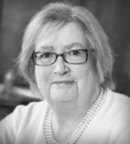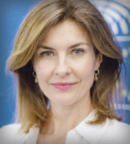The prevention of infection with the human papillomavirus (HPV), and its related cancers, has become a focus of the European Cancer Organisation. At the group’s 2020 European Cancer Summit, held virtually, members of the organization’s HPV Action Network convened with other experts to share thoughts on the problem and to push for solutions.

Margaret Stanley, PhD
The panel was held shortly after the launch of the group’s report, “Viral Protection: Achieving the Possible,” a four-step plan for eliminating HPV cancers in Europe. The report is a collaboration among a multidisciplinary group and is the first European-wide advocacy initiative to tackle HPV-caused cancers.
Simple Message: Vaccination Works
“Does HPV vaccination work? My goodness, yes,” said Margaret Stanley, PhD, President of the International Papillomavirus Society. “If you get enough girls and boys immunized, within 5 years, you have dropped the amount of virus circulating in the population by virtually 80% to 90%. In Sweden, where vaccine coverage in girls is high, cervical cancer dropped by almost 90% in the vaccinated group.”
According to Alessandra Moretti, MEC, Coordinator of the Organization’s Special Committee on Beating Cancer, if 90% of girls were vaccinated against HPV by 2030, cervical cancers would decrease by almost 90% in low- and middle-income nations, which would correspond to 60 million fewer cancer cases. If 70% of women were screened at least twice in their lifetime, and 90% of those with precancerous lesions were treated, cancer rates would decrease by 97%, resulting in 72 million fewer cases.

Alessandra Moretti, MEC
“Together, we have a chance to change the course of history. We know that cervical cancer could be eliminated globally by the end of the 21st century, using both vaccinations and screenings,” she said.
The often-cited goal of eliminating HPV-related disease by 2030 may be a bit challenging, but even with vaccine coverage of 80% per year, if achieved year after year, enough infections would be prevented to eliminate HPV-related cancers “over time,” Dr. -Stanley noted. “Cervical, anal, and oropharyngeal cancers could be pretty much like diphtheria and tetanus today: rare.” Such success can only be accomplished through “European political will, resources, and cooperation…and the sharing of best practices,” she added.
Cobi Reisman, MD, Past President of the European Society for Sexual Medicine, echoed Dr. Stanley’s sentiments. “We have a tremendous opportunity. It’s the first time in the history of medicine that we have an intervention that can directly prevent specific cancers and is also safe,” he said.

Cobi Reisman, MD
Dr. Reisman also emphasized the need for scientific organizations not only to educate the public, but the health-care professionals who influence the public. “People rely on information from them, not the government…. Studies show that when health-care professionals are educated, vaccine uptake increases.”
Achieving the Possible
Daniel Kelly, PhD Co-Chair of the European Cancer Organisation’s HPV Action Network and co-moderator of the session, stated the central recommendation of the Achieving the Possible report: The European Union and the wider World Health Organization (WHO) European region should commit to the core goal of matching and exceeding the WHO Global Strategy for Cervical Cancer Elimination and implement policies and strategies for the elimination of all the cancers and diseases caused by HPV.

“All HPV-related disease is preventable through vaccination and screening, but both are provided inconsistently and inequitably across Europe.”— Daniel Kelly, PhD
Tweet this quote
As Prof. Kelly pointed out, HPV causes 4.5% of cancers worldwide and 2.5% of those in Europe, including 87,000 new annual cases of cervical, vaginal, vulval, penile, anal, oropharyngeal, and other cancers. HPV also causes genital warts and recurrent respiratory papillomatosis. All HPV-related disease is preventable through vaccination and screening, but both are provided inconsistently and inequitably across Europe, said Prof. Kelly.
Here’s a quick look at the problem:
- Of 54 European region countries, 14 (26%) still do not vaccinate girls against HPV.
- Only 26 countries (48%) vaccinate boys against HPV or are planning to.
- Few countries meet the widely accepted target of 80% HPV vaccination coverage.
- Treatment outcomes vary by country; the 5-year survival rate for cervical cancer is 80% in Iceland but 55% in Poland and Bulgaria.
- “Fake news” about HPV vaccination safety is widely shared on social media and has resulted in steep drops in uptake—in Denmark, for example, from 90% to 54%.
The report sets out evidence-based actions on 28 recommendations encompassing 4 main fronts: universal vaccination of adolescents, population-based cervical cancer screening using accurate HPV technology, consistent cancer treatment in line with best practices, and programs to improve awareness and education and to tackle misinformation head-on.
Message From European CDC
Andrea Ammon, MD, Director of the European Centre for Disease Prevention and Control (ECDC), relayed a message from her organization. She emphasized that HPV infection renders cervical cancer the second most common cancer in young women in the European Union (EU). “That calls for action, and action indeed has been taken,” Dr. Ammon said. “All EU member states have included HPV vaccination in their national immunization programs.”

Andrea Ammon, MD
The anticipated result of such immunizations will be significant reductions in HPV-related disease. This has been observed in countries within and outside of the EU, she said.
The goal is universal HPV vaccination—of both girls and boys. “Men who have sex with men are not protected if only girls are vaccinated. Universal vaccination guarantees equity,” noted Dr. Ammon. “Vaccinating girls and boys may also allow for higher indirect protection and will help sustain a reduction in HPV circulation in the population.”
Universal access is important, but it may become necessary to prioritize the vaccinated groups. “Global vaccine shortages are forecasted for the coming years,” Dr. Ammon said, and the ongoing COVID-19 pandemic should further impact vaccination supplies.
A shortage of HPV vaccine supplies will mostly affect developing countries, to the degree that even girls will remain unvaccinated in those places. This is especially likely if other wealthier countries include boys in their HPV programs. The ECDC’s position is that should global supply diminish, vaccination of all girls should be the priority.
The ECDC has set a goal of 90% vaccine coverage of girls by age 15, a 70% HPV screening rate for young women, and a 90% access rate to treatment for precancerous cervical lesions and cancer.
Issues of compliance, access, and misinformation could make these goals difficult to attain, however, she said.
“Vaccine hesitancy” is a bigger barrier to vaccine implementation than access, according to Dr. Ammon. “We have, in recent years, seen a decline in vaccine confidence, and that has impacted our immunization programs.”
Overcoming Misinformation and ‘Vaccine Hesitancy’
No longer is information on vaccination (or virtually any scientific topic) disseminated by a few trusted sources; it is now the purview of virtually any organization and is usually accessed to confirm beliefs one already holds, said Emilie Karafillakis, MSc, European Research Lead for the Vaccine Confidence Project at London School Hygiene and Topical Medicine.

Emilie Karafillakis, MSc
Social media, blogs, and even biased scientific articles, she said, have “created a world where we remain closeted with people who share our own views and are exposed to information that belongs to our own predetermined belief.” For HPV prevention, this has resulted in questioning the benefit and safety of vaccines, the growth of the antivaccination movement, and increasing “vaccine hesitancy.”
It seems that accurate and positive information “only reaches people who already hold positive views,” she said.
Ms. Moretti commented: “Sadly, it’s the same story as with any other vaccine, where science is distorted to confuse people. It’s greatly problematic when this information touches policy, but it becomes unacceptable when it affects human health and safety.”
Structural changes can be put in place to prevent exposure to “fake news” (such as flagging and countering it as well as altering search algorithms); better tools can be developed to empower consumers to spot “fake news”; and communication and conversation with vaccine-hesitant individuals can be fostered. All these approaches must come from collaborations among social media platforms, academics, health institutes, and government, Ms. Karafillakis said.
Still, focusing only on preventing access to misinformation is not the only answer, she added. “Social media is here to stay. We have to adapt and learn how to use it…. We don’t have just one problem with vaccine confidence, and we don’t have a ‘fake news’ problem. We have a trust problem. The question is, why do people look for misinformation in the first place and not trust information that is correct? These questions are the ones we need to ask first.”
DISCLOSURE: Dr. Stanley has received honoraria from MSD and has served as a consultant or advisor to GSK Biologicals Belgium. All other participants reported no conflicts of interest.

